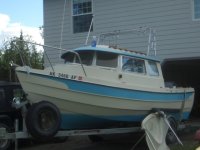Greg,
I shouldn't have used that term "marine grade". If your using stuff made for food processing it is probably same stuff which is most likely 316ss. Food industry needs the same thing as boats, NO RUST. Also I assumed most folks like stuff shiny which ain't so neither.
For aluminum, anodized is better but not necessary. Like you said if the boat doesn't live in a slip and gets babied the way mine does, bare aluminum works fine. If you saw my pics of the brackets I used for my fuel tank cover boards it is just plain old 60xx aluminum bought at the Home Depot. That's why I said we all have to do our own cost/benefit analysis to figure out where we spend our bucks.
Gary,
In addition to rusty "stainless" pliers, have you ever had a stainless steel knife blade that didn't rust if you left it dirty? Reason being is that the most rust resistant stainless are the 300 series, most commonly 316. Problem is that it is pretty soft so not so good for plier jaws, knife blades, etc. Makes a pretty knife but won't hold an edge. So 400 series stainless is usually used for tools. So what makes stainless stainless? 316 stainless is (nominally) 16% chromium, 12% nickel, and the rest regular steel stuff. 403 (which is pretty common) is 12% chromium and no nickel. The nickel is what keeps the 316 from rusting but also makes it soft. 403 is still pretty rust resistant (not rust proof) and way harder.
It's all good as long as you know what you're getting and what its limitations are.

